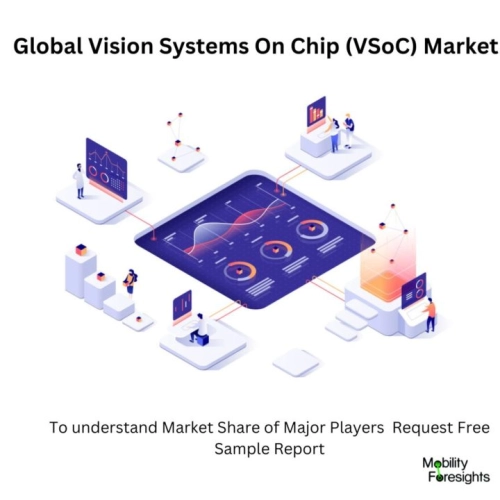
- Get in Touch with Us

Last Updated: Apr 25, 2025 | Study Period: 2023-2030
A Vision System on Chip (VSoC) is a type of integrated circuit that combines the functions of a processor, image sensor, and image processing algorithms into a single device.
This allows for image processing to be done directly on the chip, which can reduce power consumption, cost, and size compared to traditional systems that require multiple components.
VSoCs are designed to process images from cameras and other types of sensors, such as radar, infrared, and ultrasound. They can also be used for vision-based navigation, computer vision, object recognition, and other applications.
VSoCs typically feature a dedicated image processing unit (IPU) with dedicated hardware accelerators that are optimized for image processing tasks, such as image filtering, edge detection, and motion estimation.
VSoCs are becoming increasingly popular in a variety of industries, such as automotive, medical, industrial, and consumer devices.
By integrating the required components into a single chip, VSoCs can reduce the costs and complexity of development and implementation. Additionally, VSoCs can improve performance by taking advantage of the dedicated hardware accelerators.
In summary, VSoCs are integrated circuits that combine the functions of a processor, image sensor, and image processing algorithms into a single device.
They are designed to reduce cost and complexity while improving performance and power consumption. VSoCs are becoming increasingly popular in a variety of industries, and can be used for a variety of applications such as navigation, computer vision, and object recognition.

The Global Vision Systems on Chip (VSoC) market accounted for $XX Billion in 2022 and is anticipated to reach $XX Billion by 2030, registering a CAGR of XX% from 2023 to 2030.
The latest addition of the Fraunhofer vision system-on-chip (VSoC) family for high-performance image processing and acquisition applications is the IAP VSoC2M. Analogue convolution during readout is combined with fast column-parallel processing for software-defined analogue-to-digital (A/D) converters and analogue storage for image analysis and feature extraction.
It also includes an asynchronous readout path for sparse data compression and an application-specific instruction set processor (ASIP) concept for software-defined process control.
From content-based multi-region of interest (ROI) picture collection via optical measuring techniques like laser light sheet triangulation or optical coherence tomography (OCT) to feature-based process control, this opens up a wide range of new possibilities in embedded image processing.
A few or small ROIs are necessary for applications like laser light sheet triangulation or optical coherence to function, and scalar output may be sufficient for some optical control tasks.
In this way, the digital interface bottleneck of conventional high-speed image sensors is lessened by minimising the amount of data as early as possible, which accelerates A/D conversion and later processing stages.
AVSoC allows full frame speeds beyond 10kHz, latency below 100[micro]s, and does away with the requirement for additional image processing gear. Analog-digital column-parallel pre-processing using 1,024 processor elements is made possible by the two-megapixel charge-based pixel matrix that makes up VSoC2M.
32 analogue memory cells, a separate AD/DA converter, and fundamental digital processing capabilities are all present in each processor element.The functional units of the VSoC, including line control, are managed by an ASIP.
The VSoC may be utilised for event-based, compressed sensing as well as traditional methods with continuous data streams because of a compacting readout pipeline that runs in parallel to data processing.
Python software is produced using an embedded assembler. Software-defined digitisation and 1D analogue convolution operations are made possible by the VSoC idea, which combines charge-based signal processing in a column-parallel fashion with flexible ASIP-based control. With innovative techniques for row- and column-wise data compression, VSoC2M greatly outperforms its predecessor in terms of readout speed and versatility.
| Sl no | Topic |
| 1 | Market Segmentation |
| 2 | Scope of the report |
| 3 | Abbreviations |
| 4 | Research Methodology |
| 5 | Executive Summary |
| 6 | Introdauction |
| 7 | Insights from Industry stakeholders |
| 8 | Cost breakdown of Product by sub-components and average profit margin |
| 9 | Disruptive innovation in theIndustry |
| 10 | Technology trends in the Industry |
| 11 | Consumer trends in the industry |
| 12 | Recent Production Milestones |
| 13 | Component Manufacturing in US, EU and China |
| 14 | COVID-19 impact on overall market |
| 15 | COVID-19 impact on Production of components |
| 16 | COVID-19 impact on Point of sale |
| 17 | Market Segmentation, Dynamics and Forecast by Geography, 2023-2030 |
| 18 | Market Segmentation, Dynamics and Forecast by Product Type, 2023-2030 |
| 19 | Market Segmentation, Dynamics and Forecast by Application, 2023-2030 |
| 20 | Market Segmentation, Dynamics and Forecast by End use, 2023-2030 |
| 21 | Product installation rate by OEM, 2023 |
| 22 | Incline/Decline in Average B-2-B selling price in past 5 years |
| 23 | Competition from substitute products |
| 24 | Gross margin and average profitability of suppliers |
| 25 | New product development in past 12 months |
| 26 | M&A in past 12 months |
| 27 | Growth strategy of leading players |
| 28 | Market share of vendors, 2023 |
| 29 | Company Profiles |
| 30 | Unmet needs and opportunity for new suppliers |
| 31 | Conclusion |
| 32 | Appendix |